“Residents of Venezuela's southern city of Puerto Ordaz enjoy pleasant views of the Orinoco and Caroni rivers and are a half hour's drive from one of the world's biggest hydroelectric dams. Yet most days they suffer water and power cuts. The irony is not lost on Marelis Gonzalez, who runs the “Las Chinas” food store. She is fed up with constant outages that halt her fridges, making drinks lukewarm and spoiling meat. “We should be the last ones without power or water”, Gonzalez tuts at the counter on an oppressively hot morning without services in the middle-class, hilltop Villa Brasil district. “If it's like this for us, imagine those far away!”. Across the road, 82-year-old Arcelia Leandro is waiting patiently in her kitchen for power and water to cook lunch for her grandchildren. “It's been like this for three months, cuts every day. We've never had a situation like this. Horrible”.
Venezuela's energy and water problems have escalated in the last few weeks: yet another headache for the OPEC nation's 30 million people already reeling from recession, the world's highest inflation rate, and scarcities of basic goods. Officials in President Nicolas Maduro's socialist government say they can hardly believe their bad luck. After the global oil price collapse slashed revenues by more than half, along came the drought-inducing El Niño weather phenomenon. Already unpopular and facing an opposition push to remove him, Maduro has launched an energy-saving campaign and imposed rationing, although he euphemistically calls it a “Plan for Load Administration”. But the government's main hope is pinned on late rains in the south, forecast for May or June. Critics say the government is using El Niño as a convenient scapegoat to hide incompetent management of the electricity sector: insufficient investment, poor maintenance, corruption, and a failure to diversify away from the Guri which provides two-thirds of Venezuela's power. Opposition politicians have lambasted Maduro's power-saving measures, including giving state workers a two-day week, urging women to reduce the use of hair-dryers, and changing Venezuela's time-zone so there is half an hour more light in the evenings.
High up in the steep and cramped streets of Caracas' Petare slums, one of South America's biggest shanty-towns, residents count the time they last had running water – 1 year and 7 months – and need to go ever further and pay ever more to find it. Their neighborhood, ironically, is called “The Tank”, after a huge, rusting hulk of a water storage container that towers over shacks: it has been empty for years. Children snake up the hill with jerry cans filled from a well with precious loads of water. Residents purify water with vinegar, and carefully “recycle” it from kitchen to toilet. When they have money, families band together to buy a truckload of water, but the price has jumped to 25,000 bolivars – twice the monthly minimum wage – for 7,000 liters. Some channel rainwater off their roof into buckets via corrugated iron sheets. “I feel abandoned. It's humiliating. This is no life”, said community worker Yunny Perez, 46, saying her family now has to make painful choices between spending on water, food or medicines for a disabled child. “We're an oil country yet look at the poverty here”, added Perez, who used to be a “Chavista” or fervent supporter of the late president, but is disgusted with Maduro and has just begun supporting the opposition. And protests are proliferating”. – Andrew Cawthorne and Carlos Garcia Rawlins via Reuters
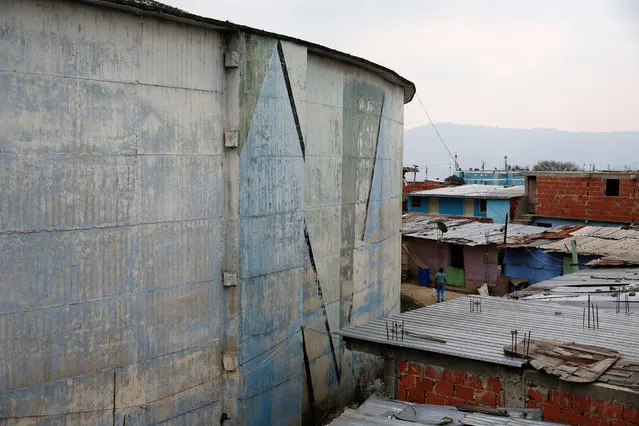
A woman walks next to a non-operative water tank in the neighbourhood called “The Tank” in the slum of Petare in Caracas, Venezuela, March 17, 2016. Although their nation has one of the world's biggest hydroelectric dams and vast rivers like the fabled Orinoco, Venezuelans are still suffering water and power cuts most days. The problems with stuttering services have escalated in the last few weeks: yet another headache for the OPEC nation's 30 million people already reeling from recession, the world's highest inflation rate, and scarcities of basic goods. President Nicolas Maduro blames a drought, while the opposition blames government incompetence. (Photo by Carlos Garcia Rawlins/Reuters)
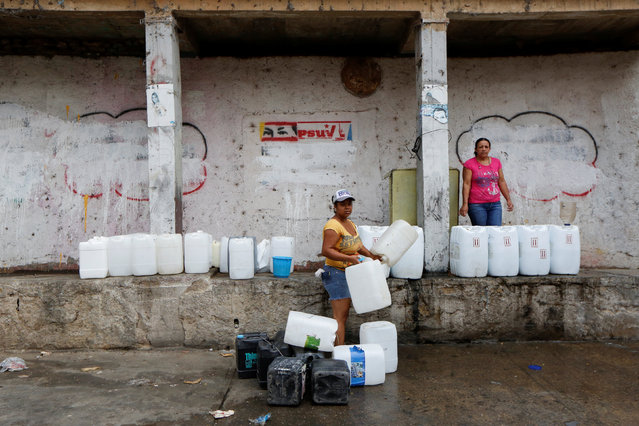
Alexandra Evaristo (C) and Balbina Ortega pose for a picture next to their plastic containers used to carry water, near a well on a street, close to a neighbourhood called “The Tank” at the slum of Petare in Caracas, Venezuela, April 3, 2016. (Photo by Carlos Garcia Rawlins/Reuters)
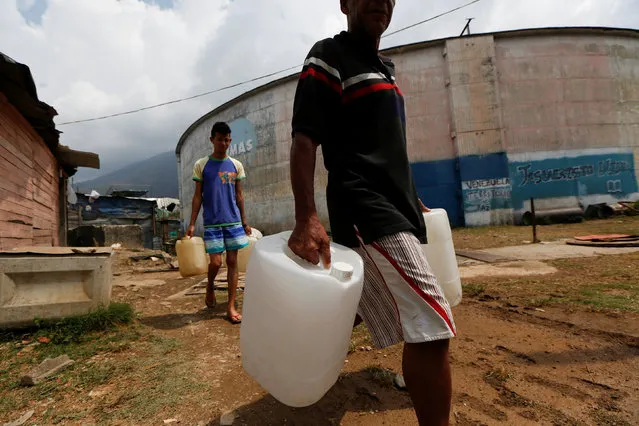
Men carrying plastic containers used for water, walk in front of a non-operative water tank, in the neighbourhood called “The Tank” at the slum of Petare in Caracas, Venezuela, April 3, 2016. (Photo by Carlos Garcia Rawlins/Reuters)
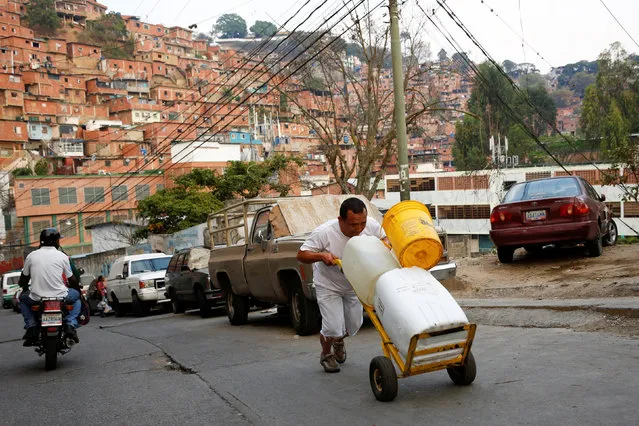
A man pushes a wheelbarrow loaded with water containers in a neighbourhood called “The Tank” at the slum of Petare in Caracas, Venezuela, March 17, 2016. (Photo by Carlos Garcia Rawlins/Reuters)
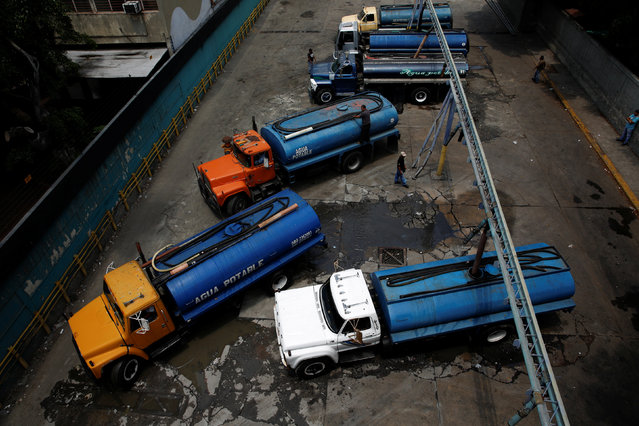
Workers fill water tank trucks at a filling centre in Caracas, Venezuela, March 18, 2016. (Photo by Carlos Garcia Rawlins/Reuters)
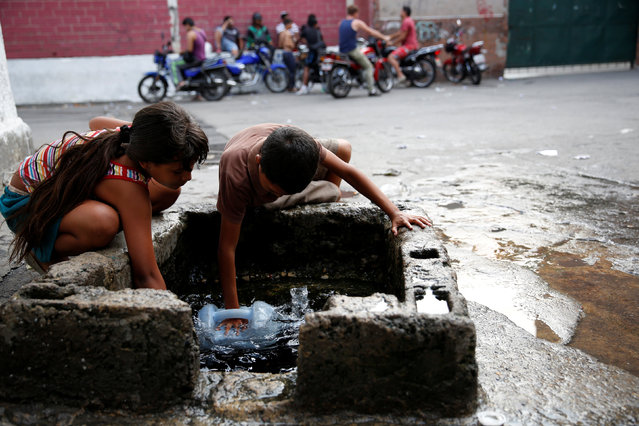
Children fill plastic containers with water from a well on a street, close to a neighbourhood called “The Tank” in the slum of Petare in Caracas, Venezuela, March 17, 2016. (Photo by Carlos Garcia Rawlins/Reuters)
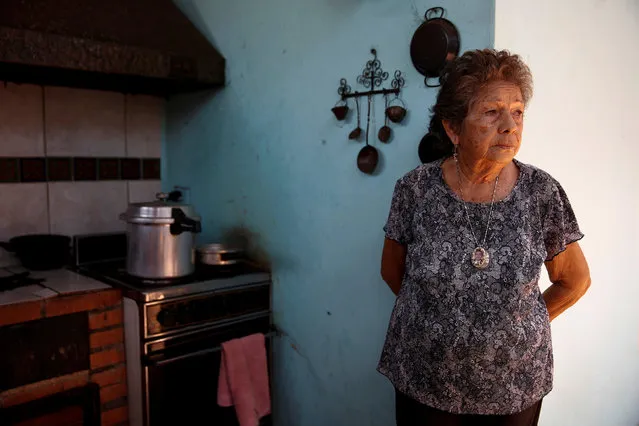
Arcelia Leandro poses for a picture at the kitchen of her house, while she waits for the power to return, during a power cut in Puerto Ordaz in Bolivar state, Venezuela, April 12, 2016. (Photo by Carlos Garcia Rawlins/Reuters)
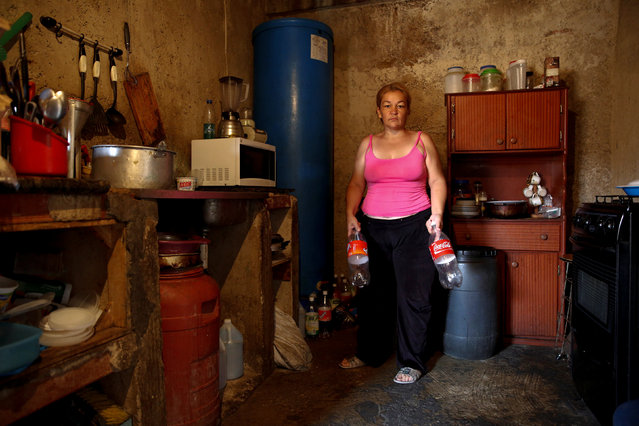
Yunni Perez holds plastic bottles used to carry water while she poses for a picture in her house, in a neighbourhood called “The Tank” at the slum of Petare in Caracas, Venezuela, April 3, 2016. (Photo by Carlos Garcia Rawlins/Reuters)
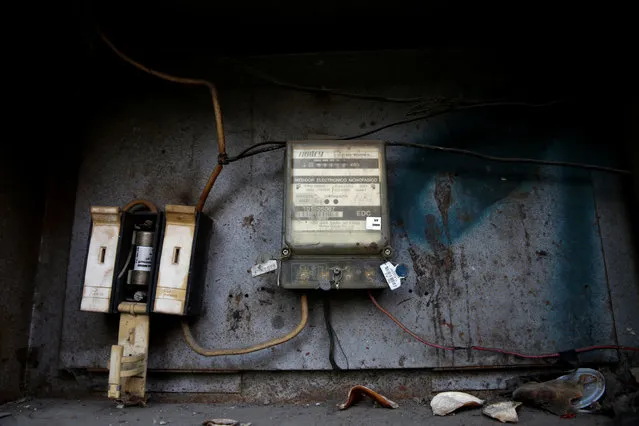
An electricity meter is seen in a house in Caracas, Venezuela, April 2, 2016. (Photo by Carlos Garcia Rawlins/Reuters)
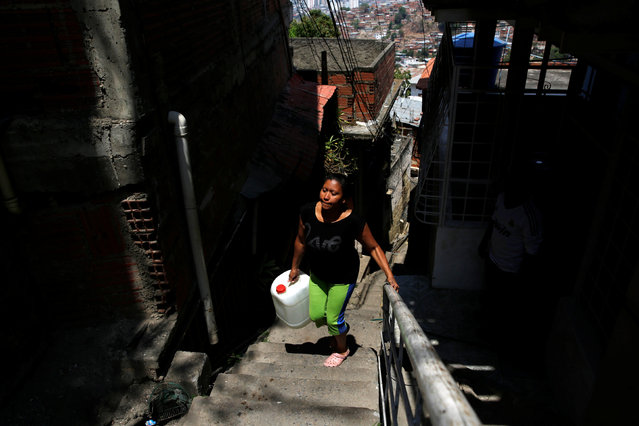
A woman carries a container filled with water up a flight of stairs at the slum of Petare in Caracas, Venezuela, March 17, 2016. (Photo by Carlos Garcia Rawlins/Reuters)
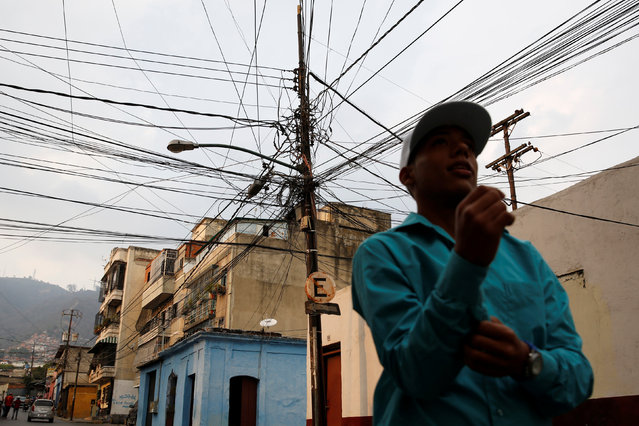
A man walks past an electric pole with overhead power cables in Caracas, Venezuela, April 2, 2016. (Photo by Carlos Garcia Rawlins/Reuters)
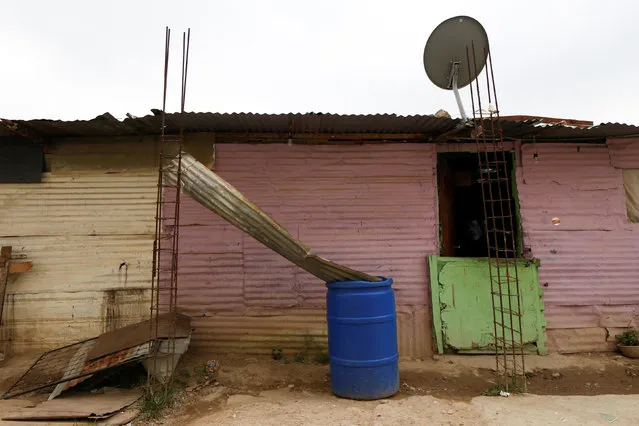
A plastic container with a corrugated metal sheet placed on top to collect rain water is seen in a neighbourhood called “The Tank” at the slum of Petare in Caracas, Venezuela, March 17, 2016. (Photo by Carlos Garcia Rawlins/Reuters)
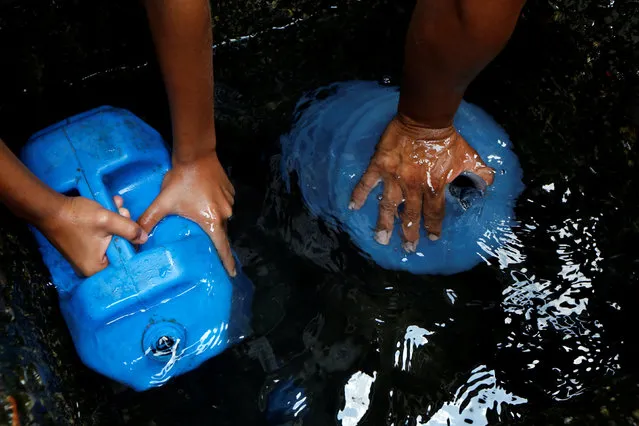
People fill plastic containers with water in a well on the street, close to a neighbourhood called “The Tank” at the slum of Petare in Caracas, Venezuela, April 3, 2016. (Photo by Carlos Garcia Rawlins/Reuters)
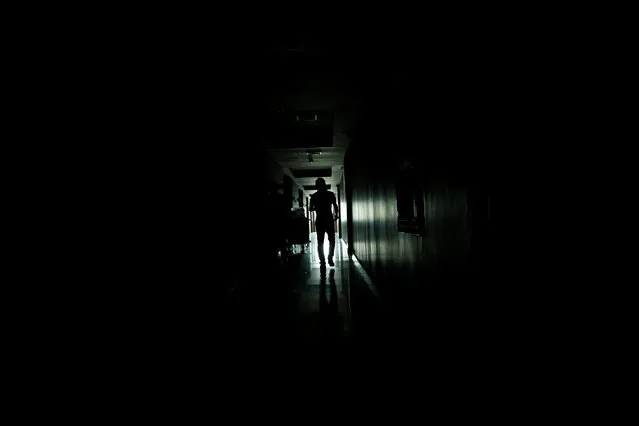
A man walks in the hallway of a hotel, during a power cut in Barinas in the state of Barinas, Venezuela, March 30, 2016. (Photo by Carlos Garcia Rawlins/Reuters)
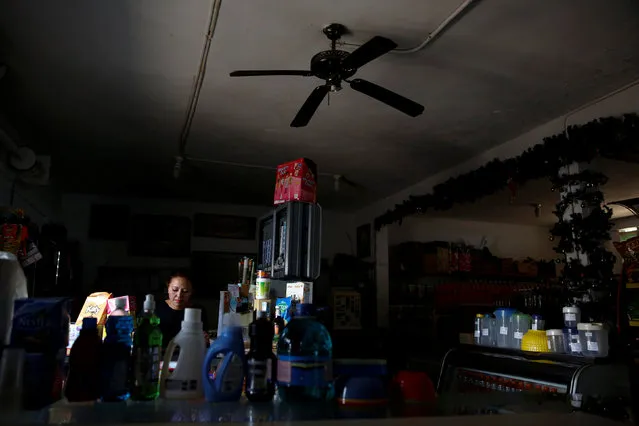
Marelis Gonzalez waits for clients in a food store, during a power cut in Puerto Ordaz in Bolivar state, Venezuela, April 12, 2016. (Photo by Carlos Garcia Rawlins/Reuters)
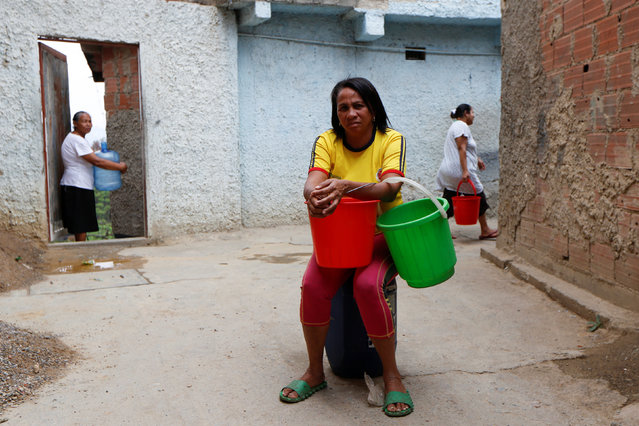
Maria Rivero, carrying plastic containers used to carry water, poses for a picture in a neighbourhood called “The Tank” at the slum of Petare in Caracas, Venezuela, April 3, 2016. (Photo by Carlos Garcia Rawlins/Reuters)
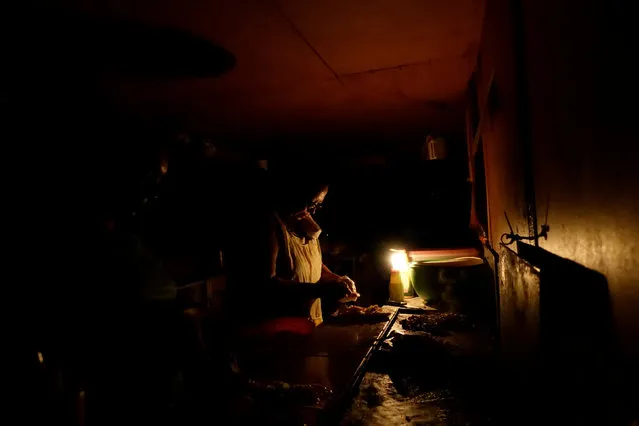
Women cook with candlelight at a street food stall, during a power cut in Tinaquillo in the state of Cojedes, Venezuela, March 20, 2016. (Photo by Carlos Garcia Rawlins/Reuters)
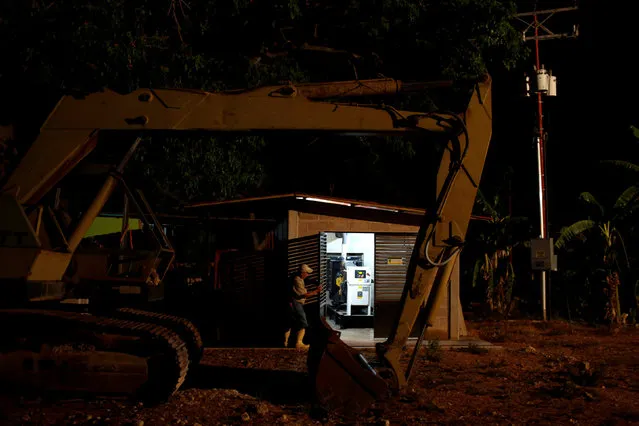
A worker inspects the electric generator at a farm, during a power cut in Tinaquillo in the state of Cojedes, Venezuela, March 20, 2016. (Photo by Carlos Garcia Rawlins/Reuters)
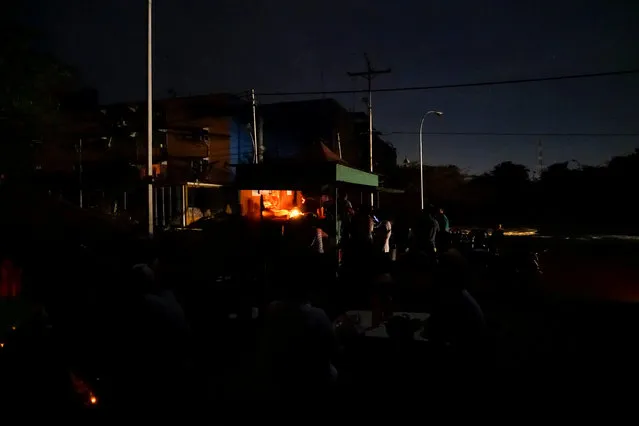
People have dinner on the dark at a street food stall, during a power cut in Tinaquillo in the state of Cojedes, Venezuela, March 20, 2016. (Photo by Carlos Garcia Rawlins/Reuters)
Venezuela's energy and water problems have escalated in the last few weeks: yet another headache for the OPEC nation's 30 million people already reeling from recession, the world's highest inflation rate, and scarcities of basic goods. Officials in President Nicolas Maduro's socialist government say they can hardly believe their bad luck. After the global oil price collapse slashed revenues by more than half, along came the drought-inducing El Niño weather phenomenon. Already unpopular and facing an opposition push to remove him, Maduro has launched an energy-saving campaign and imposed rationing, although he euphemistically calls it a “Plan for Load Administration”. But the government's main hope is pinned on late rains in the south, forecast for May or June. Critics say the government is using El Niño as a convenient scapegoat to hide incompetent management of the electricity sector: insufficient investment, poor maintenance, corruption, and a failure to diversify away from the Guri which provides two-thirds of Venezuela's power. Opposition politicians have lambasted Maduro's power-saving measures, including giving state workers a two-day week, urging women to reduce the use of hair-dryers, and changing Venezuela's time-zone so there is half an hour more light in the evenings.
High up in the steep and cramped streets of Caracas' Petare slums, one of South America's biggest shanty-towns, residents count the time they last had running water – 1 year and 7 months – and need to go ever further and pay ever more to find it. Their neighborhood, ironically, is called “The Tank”, after a huge, rusting hulk of a water storage container that towers over shacks: it has been empty for years. Children snake up the hill with jerry cans filled from a well with precious loads of water. Residents purify water with vinegar, and carefully “recycle” it from kitchen to toilet. When they have money, families band together to buy a truckload of water, but the price has jumped to 25,000 bolivars – twice the monthly minimum wage – for 7,000 liters. Some channel rainwater off their roof into buckets via corrugated iron sheets. “I feel abandoned. It's humiliating. This is no life”, said community worker Yunny Perez, 46, saying her family now has to make painful choices between spending on water, food or medicines for a disabled child. “We're an oil country yet look at the poverty here”, added Perez, who used to be a “Chavista” or fervent supporter of the late president, but is disgusted with Maduro and has just begun supporting the opposition. And protests are proliferating”. – Andrew Cawthorne and Carlos Garcia Rawlins via Reuters

A woman walks next to a non-operative water tank in the neighbourhood called “The Tank” in the slum of Petare in Caracas, Venezuela, March 17, 2016. Although their nation has one of the world's biggest hydroelectric dams and vast rivers like the fabled Orinoco, Venezuelans are still suffering water and power cuts most days. The problems with stuttering services have escalated in the last few weeks: yet another headache for the OPEC nation's 30 million people already reeling from recession, the world's highest inflation rate, and scarcities of basic goods. President Nicolas Maduro blames a drought, while the opposition blames government incompetence. (Photo by Carlos Garcia Rawlins/Reuters)

Alexandra Evaristo (C) and Balbina Ortega pose for a picture next to their plastic containers used to carry water, near a well on a street, close to a neighbourhood called “The Tank” at the slum of Petare in Caracas, Venezuela, April 3, 2016. (Photo by Carlos Garcia Rawlins/Reuters)

Men carrying plastic containers used for water, walk in front of a non-operative water tank, in the neighbourhood called “The Tank” at the slum of Petare in Caracas, Venezuela, April 3, 2016. (Photo by Carlos Garcia Rawlins/Reuters)

A man pushes a wheelbarrow loaded with water containers in a neighbourhood called “The Tank” at the slum of Petare in Caracas, Venezuela, March 17, 2016. (Photo by Carlos Garcia Rawlins/Reuters)

Workers fill water tank trucks at a filling centre in Caracas, Venezuela, March 18, 2016. (Photo by Carlos Garcia Rawlins/Reuters)

Children fill plastic containers with water from a well on a street, close to a neighbourhood called “The Tank” in the slum of Petare in Caracas, Venezuela, March 17, 2016. (Photo by Carlos Garcia Rawlins/Reuters)

Arcelia Leandro poses for a picture at the kitchen of her house, while she waits for the power to return, during a power cut in Puerto Ordaz in Bolivar state, Venezuela, April 12, 2016. (Photo by Carlos Garcia Rawlins/Reuters)

Yunni Perez holds plastic bottles used to carry water while she poses for a picture in her house, in a neighbourhood called “The Tank” at the slum of Petare in Caracas, Venezuela, April 3, 2016. (Photo by Carlos Garcia Rawlins/Reuters)

An electricity meter is seen in a house in Caracas, Venezuela, April 2, 2016. (Photo by Carlos Garcia Rawlins/Reuters)

A woman carries a container filled with water up a flight of stairs at the slum of Petare in Caracas, Venezuela, March 17, 2016. (Photo by Carlos Garcia Rawlins/Reuters)

A man walks past an electric pole with overhead power cables in Caracas, Venezuela, April 2, 2016. (Photo by Carlos Garcia Rawlins/Reuters)

A plastic container with a corrugated metal sheet placed on top to collect rain water is seen in a neighbourhood called “The Tank” at the slum of Petare in Caracas, Venezuela, March 17, 2016. (Photo by Carlos Garcia Rawlins/Reuters)

People fill plastic containers with water in a well on the street, close to a neighbourhood called “The Tank” at the slum of Petare in Caracas, Venezuela, April 3, 2016. (Photo by Carlos Garcia Rawlins/Reuters)

A man walks in the hallway of a hotel, during a power cut in Barinas in the state of Barinas, Venezuela, March 30, 2016. (Photo by Carlos Garcia Rawlins/Reuters)

Marelis Gonzalez waits for clients in a food store, during a power cut in Puerto Ordaz in Bolivar state, Venezuela, April 12, 2016. (Photo by Carlos Garcia Rawlins/Reuters)

Maria Rivero, carrying plastic containers used to carry water, poses for a picture in a neighbourhood called “The Tank” at the slum of Petare in Caracas, Venezuela, April 3, 2016. (Photo by Carlos Garcia Rawlins/Reuters)

Women cook with candlelight at a street food stall, during a power cut in Tinaquillo in the state of Cojedes, Venezuela, March 20, 2016. (Photo by Carlos Garcia Rawlins/Reuters)

A worker inspects the electric generator at a farm, during a power cut in Tinaquillo in the state of Cojedes, Venezuela, March 20, 2016. (Photo by Carlos Garcia Rawlins/Reuters)

People have dinner on the dark at a street food stall, during a power cut in Tinaquillo in the state of Cojedes, Venezuela, March 20, 2016. (Photo by Carlos Garcia Rawlins/Reuters)
08 May 2016 11:15:00,
post received
0 comments
